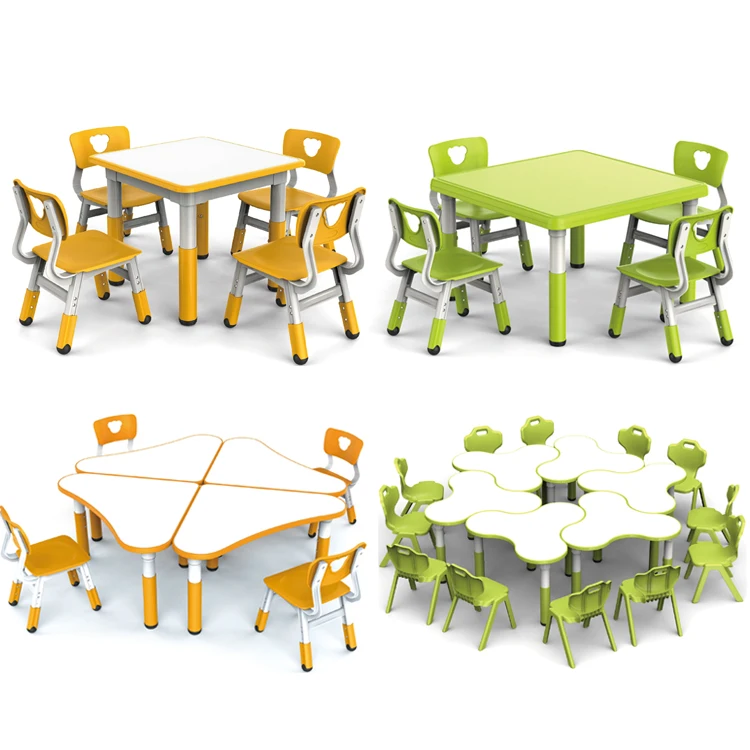31 Jan, 2024
As educators and caregivers strive to create safe and conducive learning environments for young children, the choice of materials for kindergarten furniture becomes paramount. Tables and chairs in kindergarten settings must not only withstand the rigors of daily use but also be easy to clean to maintain hygiene standards.

Here's a comprehensive guide to selecting materials that excel in both durability and ease of cleaning:
Hardwood such as oak or maple is renowned for its durability, making it an excellent choice for kindergarten furniture.
Ensure that the wood is treated or coated with a protective finish to resist scratches, stains, and water damage.
Avoid softwoods like pine, which may dent or scratch easily under heavy use.
High-density polyethylene (HDPE) and polypropylene are popular choices for kindergarten furniture due to their lightweight nature and resilience to wear and tear.
Look for chairs and tables with reinforced legs and edges to enhance structural integrity, especially in bustling kindergarten environments.
Steel or aluminum frames provide robust support for kindergarten tables and chairs, ideal for withstanding rough handling.
Opt for powder-coated finishes to prevent rust and corrosion, ensuring longevity even in high-moisture environments.
Laminate tabletops offer durability comparable to solid wood while being more budget-friendly.
Choose high-pressure laminate (HPL) for superior resistance to scratches, heat, and moisture, prolonging the lifespan of kindergarten furniture.
Select furniture with smooth surfaces devoid of intricate crevices or textures, as they can harbor dirt and germs.
Wipeable surfaces facilitate quick and efficient cleaning, essential for maintaining hygiene standards in kindergarten settings.
Opt for non-porous materials like plastic, laminate, or sealed wood, which are resistant to moisture and less prone to staining.
Non-porous surfaces also inhibit the growth of bacteria, mitigating the risk of cross-contamination among young children.
Choose furniture with stain-resistant finishes or coatings, simplifying the cleaning process and preserving the aesthetic appeal of kindergarten tables and chairs.
Consider antimicrobial treatments to further enhance hygiene and prevent the spread of germs in communal learning spaces.
Prioritize furniture with removable components such as seat cushions or tabletops, facilitating thorough cleaning and maintenance.
Ensure that removable parts are easy to detach and reattach securely to minimize the risk of accidents during cleaning routines.
Explore hybrid furniture designs that incorporate multiple materials to optimize durability and ease of cleaning.
For instance, a table with a laminate tabletop supported by powder-coated steel legs offers the best of both worlds in terms of resilience and hygiene.
Consider modular furniture systems that allow for flexible configurations and easy replacement of individual components.
Modular designs facilitate ongoing maintenance and refurbishment efforts, ensuring that kindergarten furniture remains functional and visually appealing over time.
The selection of materials for kindergarten tables and chairs should prioritize durability and ease of cleaning to create safe, hygienic, and welcoming learning environments for young children. By opting for robust materials such as hardwood, plastic, metal, or laminate with smooth, non-porous surfaces and stain-resistant finishes, educators and caregivers can ensure that kindergarten furniture withstands daily wear and tear while facilitating hassle-free maintenance routines. Additionally, exploring hybrid solutions and modular designs allows for greater versatility and longevity in kindergarten furniture, contributing to the overall well-being and educational experiences of young learners.
We are an advocate of children's exploration and growth space. From planning to implementation, from product to operation, Family of Childhood is committed to providing strategic and creative one-stop services. Contact us for more detailed information.